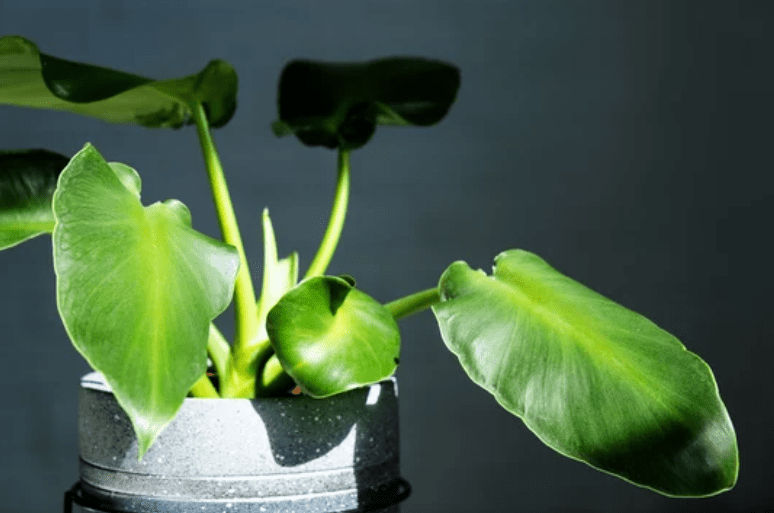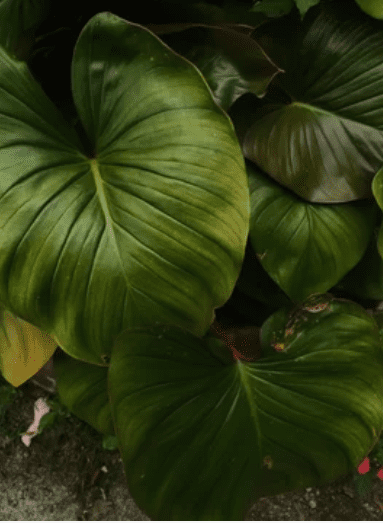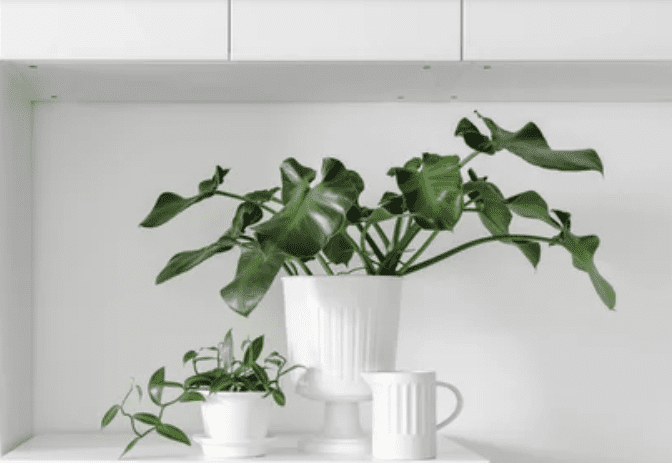
Philodendron Rugosum, also known as the Pigskin Plant, is a unique and rare plant that has captured the attention of many plant enthusiasts. Its name comes from the texture of its leaves, which resembles a pigskin.
Let’s dive deep into everything you need to know about Philodendron Rugosum, from its classification to essential information, lighting requirements, soil and potting needs, temperature and humidity requirements, fertilization process, and propagating and tackling common pests and diseases.
We will also identify common issues when growing Philodendron Rugosum and whether it can survive outdoors. Learn how to care for this beautiful plant and make it thrive in your home.
The Unique Features of Philodendron Rugosum
With its large, textured leaves resembling pigskin, Philodendron rugosum, also known as the pigskin plant, is an eye-catching houseplant that adds an exotic touch to any indoor space.
Its unique appearance makes it popular for collectors seeking a visually striking addition to their plant collection. This conversation starter is sure to impress guests and spark curiosity. Philodendron rugosum thrives in indirect sunlight and requires moist soil to thrive.
It can tolerate a wide range of temperatures and benefits from using a humidifier to maintain the average home humidity. Adding this stunning plant to your collection will elevate your indoor decor.
Why is Philodendron Rugosum called the Pigskin Plant?
Philodendron Rugosum is a rare and unusual plant that belongs to the Araceae family. It is native to South America and grows in the Andes at high elevations. It is also known as the Pigskin Plant because of its thick, leathery, and wrinkled leaves resembling a pig’s ears or hide.
This plant is adaptable and low-maintenance but needs bright, indirect light, well-drained soil, and moderate humidity. It rarely flowers indoors, but it can produce white blooms in spring. If ingested, Philodendron Rugosum is toxic to pets and people, so keep it away from curious nibblers.
Classification and Basic Information about Philodendron Rugosum
Understanding the Araceae Family in Context
The Philodendron Rugosum, like many popular houseplants, belongs to the Araceae family. This family, often called the aroid or arum family, consists of over 100 genera and about 3,750 species, including many we recognize as common indoor plants.

The Araceae family is renowned for its diverse and often exotic-looking members, each boasting unique growth habits, leaf shapes, and flowering structures. Their ability to thrive in various environments makes them favorites among plant enthusiasts.
When we talk about Philodendron Rugosum’s care and characteristics, it’s essential to remember its Araceae roots, as understanding the broader family traits can provide further insights into its optimal growth conditions and care needs.
The Rarity of Philodendron Rugosum
Philodendron rugosum is highly sought after by plant collectors due to its rarity. It is not commonly found in nurseries or online shops, adding to its desirability. The challenge lies in finding a healthy and established philodendron rugosum, as its availability is limited.
However, its scarcity comes with a higher price tag. Plant enthusiasts are willing to invest in this unique houseplant, despite the difficulty in acquiring it. Whether in Florida, California or anywhere else, the chance of finding a philodendron rugosum is like stumbling upon a treasure.
How to Ensure Proper Lighting for Your Philodendron Rugosum?
To ensure proper lighting for your Philodendron Rugosum, place it in bright indirect light. Avoid direct sunlight, as it can scorch the leaves. A south-facing window or artificial grow lights can provide the required light intensity.
Pay attention to the leaves – if they appear pale or yellowish, it may need more light. Rotate the plant regularly for balanced growth.
The Effect of Light on Philodendron Rugosum’s Growth
Adequate light is essential for the growth and development of Philodendron rugosum. Insufficient light can result in leggy growth and smaller leaves. On the other hand, too much direct sunlight can cause leaf burn and damage.
Providing the right light is crucial for promoting healthier foliage and faster growth. Maintaining a consistent light source is vital to ensure the plant thrives. By giving Philodendron rugosum optimal light conditions, you can help it reach its full potential and enjoy its lush and vibrant appearance.

The Ideal Soil and Potting Needs for Philodendron Rugosum
To provide optimal growing conditions for Philodendron rugosum, it is essential to meet its specific soil and potting requirements. This houseplant thrives in well-draining soil with a pH range of 5.5 to 7.5. A suitable growing medium can be achieved by combining peat moss, perlite, and orchid bark.
To enhance moisture retention, you can also incorporate charcoal or sphagnum moss. A pot with drainage holes is essential to prevent waterlogged soil and potential root rot. As the plant grows, repotting may be necessary to accommodate the expanding root system.
The Importance of Soil Composition
Well-draining soil composition plays a crucial role in the health and well-being of Philodendron rugosum. It allows excess water to drain away, reducing the risk of root rot. The right soil composition balances moisture retention and proper airflow to the roots, ensuring optimal growth.
For Philodendron rugosum, a mix of organic matter, such as peat moss, and inorganic components, like perlite or orchid bark, is ideal. Additionally, adjusting the soil pH to the recommended range enhances nutrient availability for the plant’s overall development.
You can help your Philodendron rugosum thrive and flourish by prioritizing soil composition.
Moss as a Soil Component and Potting Needs
Moss, specifically sphagnum moss, can be an excellent addition to the potting mix for Philodendron Rugosum. Moss aids in moisture retention while providing a light and airy environment for the roots to thrive.
To provide optimal growing conditions for Philodendron rugosum, it is essential to meet its specific soil and potting requirements. This houseplant thrives in well-draining soil with a pH range of 5.5 to 7.5.
A suitable growing medium can be achieved by combining peat moss, perlite, orchid bark, and charcoal.
Nursery Availability and Shipping
One of the challenges with the Philodendron Rugosum is finding it in a nursery. Due to its rarity, not all nurseries stock this exquisite houseplant. When seeking to add this new plant to your collection, it’s worth checking specialized nurseries or those that cater to rare and exotic plants.
Shipping a Philodendron Rugosum can be challenging, given its specific requirements. Ensure the seller packs the plant well and provides care instructions for transit. Extended shipping times can be stressful for the plant, so opt for expedited shipping when available.
Decoding the Temperature and Humidity Requirements
Maintaining optimal temperature and humidity levels is essential for the healthy growth of Philodendron rugosum. This houseplant has specific preferences when it comes to temperature and humidity.
To ensure its well-being, keeping the temperature within a suitable range and providing adequate humidity to mimic its natural habitat is essential. The right balance between temperature and moisture is crucial for this plant’s overall health and thriving.
Understanding its temperature and humidity requirements allows you to create an ideal environment for your Philodendron rugosum.
What Happens if the Temperature and Humidity Levels Are Not Met?
Neglecting the required temperature and humidity levels can harm Philodendron Rugosum. Fluctuations in these conditions may cause stress, slower growth, and leaf damage and make the plant more susceptible to pests and diseases.
Maintaining the proper temperature and humidity is crucial for this plant’s overall health and appearance.
Choosing the Right Fertilizer for Philodendron Rugosum
When choosing the right fertilizer for your Philodendron rugosum, there are a few key factors to consider. First and foremost, selecting a fertilizer specifically formulated for this houseplant is essential.
Additionally, organic options can provide a more natural approach to feeding your plant. Look for fertilizers with balanced essential nutrients to support healthy growth. It’s also important to consider the plant’s current stage of development when choosing a fertilizer.
Finally, always follow the manufacturer’s instructions for proper application and dosage.
The Magic of Stem Cutting in Philodendron Rugosum Propagation
One of the most fascinating aspects of the Araceae family, including the Philodendron Rugosum, is their ability to propagate through stem cuttings. Stem cutting is a popular method wherein a section of a healthy stem is taken from the parent plant to create a new individual.
For Philodendron Rugosum, this method is particularly effective. Ensuring the cutting includes at least one node, the section can be planted in a suitable medium, like a mix of peat moss and perlite, to encourage root development.
Within a few weeks, given the right light and humidity conditions, these cuttings can establish roots and grow into robust new plants. Stem cutting not only offers a chance to multiply your Philodendron Rugosum collection but also serves as a testament to the adaptability and resilience of the Araceae family.
Identifying and Tackling Common Pests and Diseases in Philodendron Rugosum
Look for common pests such as spider mites and mealybugs when caring for your Philodendron Rugosum. Regularly inspect the plant for any signs of infestation, such as webbing or white cotton-like substances.
If you spot these pests, you can use organic or chemical treatments to address the issue. Additionally, it’s essential to prevent diseases like root rot by ensuring proper drainage and avoiding overwatering. Creating a clean and healthy environment will also help minimize the risk of pests and diseases.
What are the Common Issues with Philodendron Rugosum?
Potential issues with Philodendron Rugosum include droopy leaves from overwatering or underwatering, yellowing or browning leaves from nutrient deficiencies or improper light exposure, leaf spots from fungal or bacterial infections, and stunted growth from inadequate light, temperature, or nutrients. Address these issues promptly to prevent further damage.
Can Philodendron Rugosum Survive in Outdoor Conditions?
Philodendron rugosum is best suited for indoor cultivation due to its specific temperature and humidity requirements. Outdoor conditions may not provide the optimal environment, potentially harming the plant. It is safer to keep philodendron rugosum indoors, but you can temporarily move it outdoors during favorable weather conditions.
Final Thoughts
In summary, the Philodendron Rugosum, also known as the pigskin philodendron, is a distinctive tropical plant from Ecuador, admired for its aberrant form and dark, full-sized green leaves. This fussy plant favors a living space with proper humidity and an ideal temperature range conducive to its growth zones, as defined by the USDA.
When it comes to the repotting section, selecting a nursery pot with adequate drain is crucial, and an optimal mix consisting of part perlite, part peat soil, and part orchid bark is recommended to maintain the suitable pH value. Locating the perfect spot, preferably near an eastern-facing window receiving partial sun, is significant for the philodendron rugosum flower and the overall propagation of the philodendron rugosum pig skin plant.
Regular, occasional misting and liquid fertilizer, mainly organic, are ideal for maintaining its health, and placing a trellis can support its larger leaves, which can reach several inches in size. Wearing a pair of gloves during these processes is advised to protect oneself. Moreover, layering gravel is a beneficial next step to enhance the stability of the plant in its decorative pot.
Whether your residence is in Miami or elsewhere, being the lucky person to own this plant will undoubtedly enhance your living space. And, for those considering purchasing online, many suppliers offer free shipping, and it’s advisable to check their privacy policy and other info related to their products and services.
With proper care and attention to details like pot size and ideal environment, the Philodendron Rugosum will be a valuable addition to any collection of philodendron plants.






















